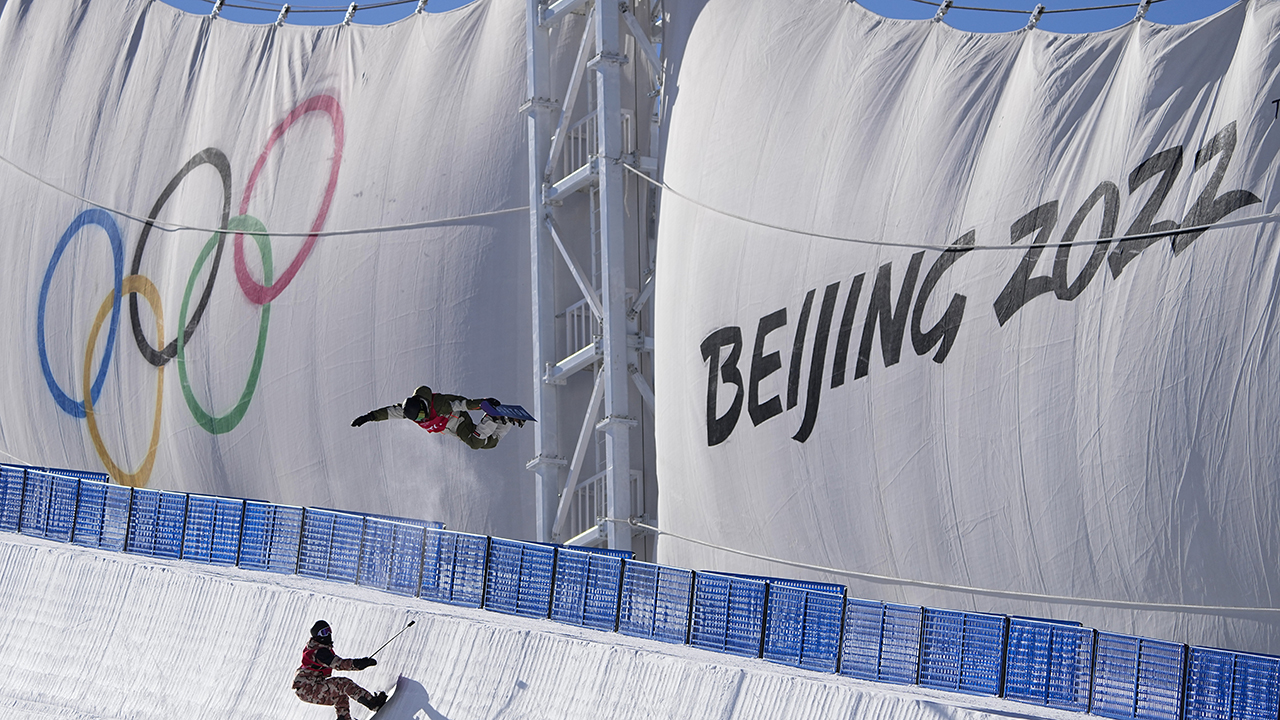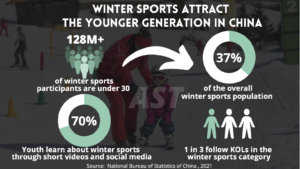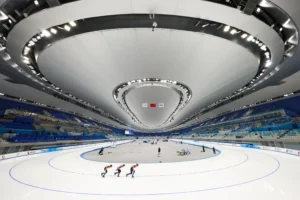
China is currently one of the fastest-growing winter sports economies in the world. Ever since 2015 when China won the bid to host the Beijing 2022 Winter Olympics and Paralympics Games, the Central Government has heavily invested in winter sports and pursued its comprehensive Winter Sports Development Plan (2016-2025) to become the next Winter Sports power. Unprecedentedly, Beijing will be the world’s first “Dual Olympic City”, and this is not only a source of national pride but it has accelerated the growth of the entire winter sports market with sustainable benefits for the country and its people. As we previously mentioned, China’s winter sports craze will be one of the key trends transforming Asia’s sports ecosystems in 2022. In this article, we will further break down the impact of Beijing 2022 on China’s sports ecosystem.
1. New national sports for all
China is leveraging the 2022 Winter Olympics to encourage interest and participation amongst Chinese of all ages and has implemented many new policies as part of its national fitness program. (Read AST’s article on opportunities in the China Fitness Market). Even before the event was held, the results of these policies were already visible as winter sports are becoming more mainstream national sports for Chinese citizens.
China’s goal is to motivate over 300 million citizens to participate in winter sports by 2025. By the end of 2021, this number has already exceeded 345 million people according to data from the National Bureau of Statistics of China. Nearly 40% of the population have participated in winter sports at least once a year and 11% of them are considered as frequent participants who do winter sports at least 3 times a year within a 12-month period.
Public enthusiasm for winter sports can be attributed to the boom in the construction of facilities that are extremely accessible to the citizens. According to government’s data, by early 2021, 654 ice rinks and 803 indoor and outdoor ski resorts have been built, an increase of 317% and 41% respectively compared to 2015.
Given its accessibility and popularity further boosted by the Winter Olympics, China will continue to see an increase in participation in winter sports. This in turn will accelerate growth and consumption in other sub-sectors including winter sports apparel and equipment, sports education and training, skiing tech and sports tourism and winter sports will become another key pillar of China’s sports economy.
2. Boosting winter sports equipment and outdoor brands
The Chinese Government’s active promotion of winter sports ahead of Beijing 2022 has triggered demand for winter sports apparel and equipment that has allowed retailers, manufacturers and outdoor brands to achieve rapid sales growth.
With the rising number of ski resorts and skiing population, China’s skiing equipment market expanded by 4 times from 2014 to 2019, growing from US$406 million to US$1.9 billion according to the Ski Industry White Book by MOB 2020. JD.com indicated that in 2021, the sales volume of winter sports goods increased by 120%.

Winter sports apparel and equipment are highly profitable but at the same time very competitive. Anta, a Chinese sports equipment conglomerate obtained the merchandising rights of Descente in China in 2016, and acquired Amer Sports in 2018 which includes Artteryx and Soloman. As well, German winter wear brand Bogne signed a joint venture with Bosideng to expand in China and many foreign brands that specialize in skiing and snowboarding gear have also entered the Chinese market such as Burton, Spyder, Helly Hansen and Head.
As winter sports have shifted from niche sports to mass sports, winter sports communities of all types are expanding and the market is full of growth opportunities. To have long term success , brands hoping to stand out from their competition require keen insights and strategies including: having clear brand positioning; understanding Chinese consumers and the preferences of casual versus avid skiers; managing the supply chain and distribution; and, creating localized offerings and products.
3. New favorite sports of Chinese youth
Although the government is not targeting specific age groups, winter sports appear to be more popular amongst the younger generation. According to the government’s research, 128 million of the participants are under 30, accounting over 37% of the total winter sports population, while the participation rate of 18-30-year-old is the highest amongst other age groups.
Another significant finding from the report “Chinese youth participation in winter sports 2021” shows that nearly 70% of youth learn about winter sports through short videos, and through social media platforms and more than one-third of them follow bloggers and idols of this category. This age group tends to consume online as well. Youth, particularly Gen Z, have high spending power and there are opportunities for companies and brands that leverage content creation and social media.

In addition to making winter sports more universal and nurturing the next generation of talents, the government has put in a lot of work at the grassroot level, such as introducing winter sports programs on school campuses across different cities. According to the government’s data, the number of schools that incorporate winter sports programs in their curriculum will rise from 2062 in 2020 to 5000 in 2025. The government has also established 125 district-wide youth winter sports teams, 5 city-wide youth ice hockey teams and a city-wide skiing team. This increase in participation of Gen Z also creates massive opportunities in the youth sports market with increased demand for coaches, winter sports programs and training academies. Skiing tech will also play an important role to deliver immersive and personalized training.
4. A new world-class destination for winter sports tourism
The Winter Olympics 2022 has ignited the enthusiasm of Chinese citizens for winter sports tourism. The government recently set out a development path for tourism in the 14th Five-Year Plan showing its ambition to actively promote winter sports tourism and create world-class ski tourism resorts and destinations.

According to research from the Ministry of Culture and Tourism, the number of tourists who go on winter sports-related trips increased (even during the pandemic) rising from 170 million in the 2016-17 winter season to 254 million in the 2020-21 winter season. The upcoming Winter Olympics is expected to further increase the number of winter sports tourists to reach 305 million in the 2021-22 winter season, generating US$50.7 billion of revenue. Beijing 2022 is also contributing to the rapid growth of China’s sports tourism industry with recent research by the China Tourism Academy indicating that 72% of domestic travellers intend to maintain or increase their spending on winter sports holidays while 68% of them intend to increase their frequency of these holidays. We are also seeing more capital flowing into this space. LeadLeo’s China Ice & Snow Report 2021 indicated that the overall investment value in China’s winter sports tourism from 2018 to 2020 exceeded US$141billion, and this amount is expected to further increase.
With more alpine resorts being built the number of regional and global winter sports tourists will also grow. As the market gets more competitive, winter sports related tourism companies in China will need to be innovative and determine how to best bundle different offerings and provide services that blend culture, sports and technology with facilities so that these resorts can compete with those in Japan and Korea. (Read about general sports tourism market in China.
5. Spurring winter sports investment activities
Beijing 2022 and China’s vision for winter sports has spurred investment in the sports and sports tech market and skiing is becoming a category that is highly sought after by Chinese corporations.
China’s winter sports industry is scaling up rapidly, with market revenues increasing from US$42 billion in 2015 to US$94 billion in 2020 and are expected to reach US$172 Billion by 2025 which will make up about one-fifth of the entire sports industry in China.
The 21st Century Business Herald reported that in 2021, there were thirteen winter sports-related funding rounds, involving nine companies, three of them went through two funding rounds in the same year, including X-SUMMER, SNOW51 and Snowyowl Tech. SNOW51 – China’s leading one-stop-shop ski education and retail platform and SKINOW – an indoor skiing training academy, both raised over US$15.7million in their funding rounds.
Investment activity in the overall domestic sports industry has also been very active last year. According to the data from IT JuzI, as of October 2021, there were 43 funding rounds with total financing reaching US$1.5 billion exceeding investment levels in both 2019 and 2020.
The implementation of the National Fitness Plan is already creating a favourable investment climate in China’s sports and fitness sector, and the winter sports craze will further accelerate overall sports and sports tech investment in the years to come. Although these are mainly domestic investments to date, with the growing popularity of and increasing consumption of winter sports will provide many opportunities that global firms and investors should take advantage of and consider investing in China’s winter sports ecosystem.
Key Takeaways
As the IOC president Thomas Bach said: “Beijing 2022 will change the landscape of winter sports forever.” The success of Beijing 2022 will mark a milestone for China and will significantly accelerate the development of winter sports domestically, regionally and globally. The industry will continue to rapidly evolve and we expect to see even more opportunities for growth and investment in the dynamic winter sports market in China.
Connect with us to learn more about the opportunities in China’s Winter Sports Market.







